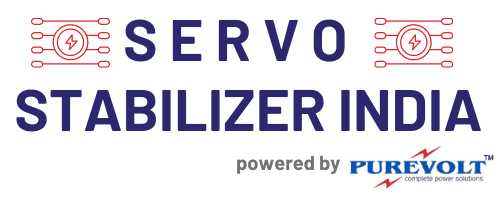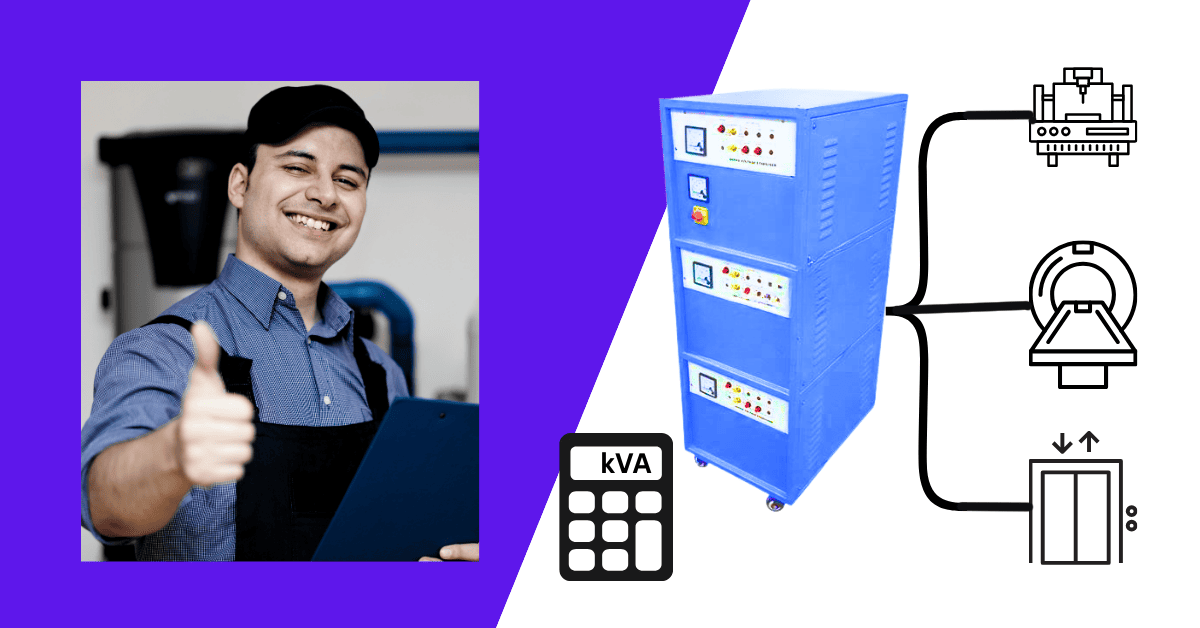Picking the right servo stabilizer is essential for all industries using costly and sensitive machines like elevators, CNC machines and MRI scanners. A wrong servo stabilizer can cause overheating, undervoltage and even the permanent breakdown of expensive devices.
This article provides a step-by-step guide for sizing the right servo stabilizer, and it will also introduce you to a simple kVA calculator.
Why is proper sizing of a servo stabilizer important?
Electricity is not constant in industries. CNC machines draw more starting currents, MRI scanners need stable voltage for imaging, and elevators function with fluctuating loads. If your servo stabilizer is undersized, it will not stabilize the voltage accurately; conversely, if it is oversized, you may incur unnecessary extra costs.
Thus, understanding the correct way to measure the servo stabilizer capacity in kVA is so important.
Step-by-step Servo Stabilizer Size calculator— India-Friendly Method
This is the simple formula to calculate the required size of the servo stabilizer.
Stabilizer Capacity (kVA) = Total Load (kW) ÷ Power Factor × Safety Margin
1. Spot the load in kW – You can look at the nameplate on the machine or the user manual of the machine to identify the kW.
Example: The CNC machine load is 22 kW, and the MRI scanner’s load is 75 kW, and the elevator’s load is 15 kW.
2. Verify the power factor (PF): Many industrial machines typically have a power factor of approximately 0.8.
3. Use the following formula: load divided by PF.
- CNC: 22 ÷ 0.8 = 27.5 kVA
- MRI: 75 ÷ 0.8 = 93.75 kVA
- Elevator: 15 ÷ 0.8 = 18.75 kVA
4. Add safety margin (10-20%)—always consider a little extra capacity for starting surges and future expansion of load.
Final Result:
- CNC machine = approximately 30 kVA stabilizer
- MRI scanner = approximately 100 kVA stabilizer
- Elevator = approximately 20–25 kVA stabilizer
A selection guide for industrial voltage stabilizers
The following considerations should be made before choosing any stabilizers:
Type of load: The kind of load For lifts, MRI scanners, or CNAs, for example.
Three-phase versus single-phase: A three-phase servo voltage stabilizer is required for the majority of industrial machines.
Input voltage range: Assess whether the stabilizer is compatible with your local supply conditions, for example, 340 to 480 V.
Efficiency & accuracy: Always pick stabilizers with >98% efficiency and ±1% correction accuracy.
Brands and warranties: Reputable manufacturers ensure quality, after-sales service, and spares.
To avoid expensive downtime, you should keep the points above in mind.
Automatic voltage regulator versus Servo Stabilizer? Which is better?
The most common question in industries is which one is better, AVR or Servo stabilizer?
AVR (automatic voltage regulator): Automatic voltage regulators, or AVRs, operate more quickly than servo stabilizers but are better suited for smaller loads, such as those found in computers, TVs, labs, etc.
Servo voltage stabilizer: These machines are designed to take care of heavy loads of industrial machines like MRI scanners, CNC machines and elevators. These devices use servo motors for precise voltage regulation and are quite fast at managing any voltage fluctuations.
According to the final decision, servo stabilizers are better suited for heavy-duty industrial and medical equipment, while AVRs are sufficient for smaller electronic devices.
Conclusion
The correct sizing of your servo stabilizer ensures the long life of your machines, saving more energy and less downtime. To determine the appropriate size of a servo stabilizer, you can use the calculating formula: Stabilizer Capacity (kVA) = Total Load (kW) ÷ Power Factor × Safety Margin. This applies whether you need a 30 kVA servo stabilizer for CNC machines, a 100 kVA servo stabilizer for an MRI scanner, or a 25 kVA servo stabilizer for lifts. ensures you invest wisely.

